#Contemporary Japanese Cinema
Photo


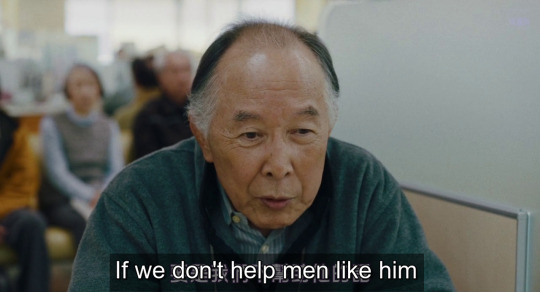
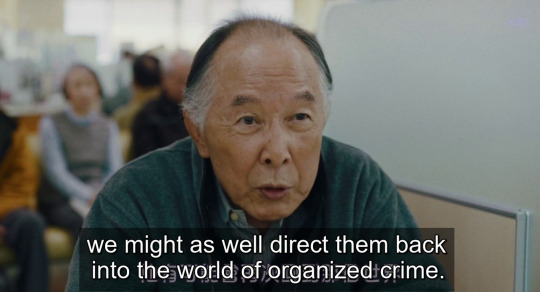
すばらしき世界 [Under the Open Sky] (Miwa Nishikawa - 2020)
#すばらしき世界#Under the Open Sky#Miwa Nishikawa#jail#Contemporary Japanese Cinema#Kōji Yakusho#Taiga Nakano#Yukiya Kitamura#Seiji Rokkaku#Hakuryu#yakuza#prison#Japanese people#Narumi Yasuda#Meiko Kaji#Ryûzô Saki#Subarashiki Sekai#Isao Hashizume#tattoo#freedom#life#Masami Nagasawa#Japanese society#drama film#wisdom#friendship#friends#orphanage#detention#second chances
10 notes
·
View notes
Text
Japanese Movies In Iran
Ten great movies by Japanese filmmakers have been chosen to be screened during the program, which has been in progress since April 11.
Below: A scene from Japanese director Takeshi Kitano’s 2002 movie “Dolls”.
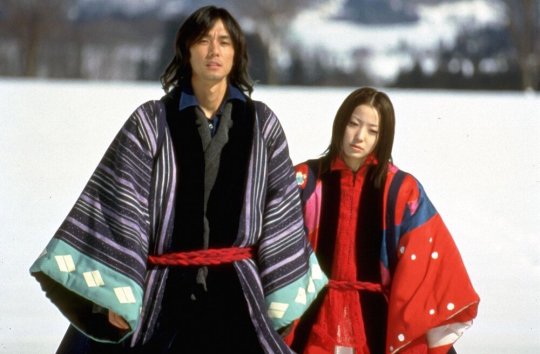
One screening has been scheduled for each film, which is held every Monday and is followed by a review session by an Iranian critic.
Director Takeshi Kitano’s 2002 movie “Dolls” will be screened at 5 pm followed by a review session by Iranian critic Mehdi Malek.
In this visually stunning drama, three romantic tales are told using elements of Japanese Bunraku puppet theater.
In the first, Sawako (Miho Kanno) becomes suicidal when her fiancé, Matsumoto (Hidetoshi Nishijima), leaves her to marry the boss's daughter. Next, an obsessed fan, Nukui (Tsutomu Takeshige), expresses his love for pop singer Haruna (Kyoko Fukada) in a highly violent manner. Then, aging gangster Hiro (Tatsuya Mihashi) attempts to reconnect with an old flame (Chieko Matsubara).
“Dreams”, a 1990 magical realist film of eight vignettes written and directed by Akira Kurosawa, and “Labyrinth of Dreams”, a 1997 mystery film directed by Gakuryu Ishii, were screened over the past two weeks.
The program also features “Nobody Knows”, director Hirokazu Koreeda’s 2004 drama film based on the 1988 Sugamo child abandonment case.
“The Taste of Tea”, the third film by writer and director Katsuhito Ishii, which has been referred to as a “surreal” version of Ingmar Bergman’s “Fanny and Alexander”, will also be screened.
“The Hidden Blade”, a 2004 film set in 1860s Japan, directed by Yoji Yamada, is another highlight of the program. The film follows several samurai during a time of change in the ruling and class structures of Japan.
Also included are “The Mourning Forest” by Naomi Kawase, “Tokyo Sonata” by Kiyoshi Kurosawa, “Confessions” by Tetsuya Nakashima and “13 Assassins” by Takashi Miike.
Source:https://www.tehrantimes.com/news/471977/Iranian-Artists-Forum-reviews-contemporary-Japanese-cinema
#Iran Tehran#TehranTimes#Iranian Artists Forum#review#Contemporary Japanese Cinema#director Kitano Takeshi#北野 武#director Kurosawa Akira#黒澤明#director Koreeda Hirokazu#是枝 裕和#director Ishii Katsuhito#石井 克人#director Yamada Yōji#山田 洋次#director Kawase Naomi#河瀨直美#director Tetsuya Nakashima#中島哲也#director Miike Takashi#三池 崇史#Iran Japan relations
6 notes
·
View notes
Text

‘Arte Evangelica’
A curation of mixed media and gif scenes from Neon Genesis Evangelion
Credits to original creator and the respective artists
#ngeedit#nge#neon genesis#neon genesis evangelion#neon genesis fanart#mixed media#christian art#christian imagery#avant garde#modern art#religious art#fine art#mixed media art#artwork#contemporary art#avant garde art#japanese cinema#1990s anime#90s anime#classic anime#anime edit#classic art edit#art edit#old anime#anime#anime aesthetic#retro anime#anime style#anime art#animecore
18 notes
·
View notes
Text
Free MIT online courses that sound interesting
Arts & Literature
Introduction to World Music
Reading Fiction
Literary Interpretation: Virginia Woolf's Shakespeare
Introduction to Photography
Foundations of Western Culture II: Renaissance to Modernity
Studies in Poetry - Briths Poetry and the Sciences of the Mind
Studies in Literary History: Modernism: From Nietzsche to Fellini
Screen Women: Body Narratives in Popular American Film
Studies in Poetry: "What's the Use of Beauty"
Queer Cinema and Visual Culture
Monteverdi to Mozart: 1600 - 1800
Writing and Experience: Reading and Writing Autobiography
Advanced Topics in Hispanic Literature and Film: The Films of Luis Buñel
Major Authors: Rewriting Genesis: "Paradise Lost" and Twentieth-Century Fantasy
Arthurian Literature and Celtic Colonization
Contemporary Literature: Britsh Novel Now
Studies in Poetry: 20th Century Irish Poetry: The Shadow of W. B. Yeats
Writing About Literature: Writing About Love
Introduction to European and Latin American Fiction: Great Books On The Page and On The Screen
Popular Culture and Narrative: Use and Abuse of the Fairy Tale
Victorian Literature and Culture
Reading Poetry
English Renaissance Drama: Theatre and Society in the Age of Shakespeare
Introduction to Fiction
International Woman's Voice
Major Authors: Oscar Wilde and the "90's"
Prizewinners: Nobelistas
American Authors: American Women Authors
Shakespeare, Film and Media
Japanese Literature and Cinema
Woman's Novels: A Weekly Book Club
Classics of Chinese Literature
Major English Novels
Topics in South Asia Literature and Culture
Introduction to Literary Theory
History & Social Studies
American Classics
The Middle East in the 20th Century
Africa and the Politics of Knowledge
The Rise of Modern Science
European Imperialism in the 19th and 20th Century
Philosophy of Love
Human Rights: At Home and Abroad
The Nature of Creativity
Introduction to Comparative Politics
Riots, Rebellions, Revolutions
Introduction to the History of Technology
Ancient Philosophy
Youth Political Participation
#studyblr#study resources#dark academia#light academia#chaotic academia#romantic academia#adhd academia#studyblr brazil#literature#art academia#mit#free courses#study#collegeblr#studyblr college
1K notes
·
View notes
Text
racism in Nintendo 2: electric boogaloo
hello and welcome back it is i, once more. to talk about the elephant in the room that has reappeared in the release of the totk designs. a suspiciously green elephant i might say
this is of course about ganon
i have made a few posts before about ganon - about how it's not anti-racist to 'redeem' his role as an all-evil villain by sexualising him; about the fan response to the first totk trailer and the rehydrated ganondorf trend; and how other characters (namely link) do not get the same treatment that ganon gets for similar design features.
what i want to give today is a more straightforward explanation of 1. why it is bad that ganon is green (yes, it is in fact bad) and 2. the orientalism inherent in his totk design. i know a lot of people find him hot, and might become defensive that i'm pointing out features that they enjoy. the fact of the matter is that the sexualisation of totk ganon is done by deliberately playing upon erotic orientalist tropes and this is something that shouldn't be ignored for personal comfort.
so to start. the green skin. im going to quote an article called Greenface: Exploring green skin in contemporary Hollywood cinema by Brady Hammond, which can be summed up by the arguement in the
"article [is] that as overtly racist cinematic depictions associated with real-world skin colors – particularly black skin – have decreased, Hollywood cinema has relocated those tropes onto green skin."
and I agree. I've talked about coding before in relation to loz, and it is no stretch to consider that a character can be representative of some particular demographic(s) without replicating their features in their entirety.
Without doubt it is straightforward to say that ganon represents a brown or black man. The gerudo are heavily inspired by the SWANA region, and not to mention that most of the gerudo indeed have a brown skin tone. botw having lighter and darker skinned gerudo is still representative of the SWANA region and the variety of looks we have there.
and thus coding done with ganon's design - intentional or otherwise - cannot escape the racial implications that ganon is very clearly a brown or black man. which means negative coding that coincides with preexisting racist coding and racial stereotypes will carry those same racist undertones. none of it is undermined by that nintendo is a Japanese company or that this is a fictional world in a video game. deliberate design choices made by real people can't be absolved from racism when it's convenient
to start:
"David Batchelor states that ‘color has been the object of extreme prejudice in Western culture’. This prejudice, he argues, manifests itself by either dismissing color outright as ‘superficial’ or by denigrating it and ‘[making it] out to be the property of some “foreign” body – usually the feminine, the oriental, the primitive, the infantile, the vulgar, the queer or the pathological’."
and
"More importantly, given the ability of the cinema screen to render fantastic spaces and colors it is necessary to consider how characters are represented when they feature an unnatural or even impossible skin color."
the gerudo have always had an orientalist lens laid over them. ganon has always had strong animalistic associations, and has appeared non-human a number of times. this was fine before nintendo retconned him to specifically be a brown man from a group that are explicitly human in the same way that hylians are human and other round-eared people in the loz franchise are human. it is racist to seperate the gerudo exclusively from other human groups as having explicitly non-human characteristics given their prolific role as the first group of brown humans in tloz, and the most foreign and exoticized group of humans.
to give ganon green skin is thusly, a way that implicitly denies his humanity. and it becomes pointed when this primitive and animalistic coding occurs most frequently to the brown man villain. now that totk revived ganon as a humaoid it becomes more pointed that he's denied the same human skintone of the rest of the gerudo, and it's quite frankly upsetting to see this happen and to be glossed over.
more specifically. green has preexisting racist associations for black and brown characters specifically. that is because green has long been used in media to depict the racialised other by linking them with real world negative racist stereotypes. an example given in the article "in Star Trek (1966-1969) when an alien woman of the Orion race dances. Her skin is an emerald green and she is both hyper-feminine and an alien Other." not commented upon but which is more evidence to the racial stereotyping of green skin is that the orion woman is depicted in a distinctly orientalist manner: with a hypersexualized outfit and routine that is reminiscent of belly dancer fantasies. the low light, setting choices, and recurring theme of the slave women dancing provocatively plays upon the western imaginations of the Harem.
as you can see:

other examples of the green other include orcs (with their own swath of racial stereotypes), the grinch, aliens, gremlins, goblins, etc. what often occurs is that green characters are concurrently linked to ethnic stereotypes through coding that is brought together in the fantasy realm by their green skin. that coding may include racism, orientalism, xenophobia, antisemitism, anti-indigenous stereotypes or so on. it is clear that ganon representing a brown/black man brings with it negative coding in the game as the only villain, his animalistic associations, his domineering violence that stands apart from the primarily female gerudo, and as the racialised other. this coding would still exist if he was not green. but it is an affront to dignity to remove the humanity of a brown man by also making him green.
if i have not yet lost you then to wrap up: the fetishizing other. as established with his coding, ganon's humanity is put into question with his design, and he can be linked to the SWANA region. evocative of a harem is the only (violent and dangerous) man from a group of women who are hidden away, and is explicitly a danger to both them and western/hylian rule and ideology.
His imagery is paired with similar design choices made for the gerudo women to sexualize him and invoke imagery of the sexy orient, the beast that can be tamed, and so on. This is done primarily with his torso being bare while he wears gold jewelry, in a way almost reminiscent of chains or cuffs. brown and black men are fetishized through sexualising them as erotic beasts, which is clear to the image that totk ganon's design presents. even the toe rings play into this - as a practice with a long history in India as worn by married women (and men, in Tamil culture).
much akin to the face veil for women, brown and black men are often sexualised through (usually gold) jewelry. specifically (like with the veil) the juxtaposition between their lack of full covering (bare torso is most common) and the abundance of ornamental jewelry. it shows their body as this exotic, decorated prize, where their nudity is highlighted by what they do wear. [this remains true despite the real world groups in the swana region that have traditionally topless outfits for men. that sort of respectful and researched depiction of cultural outfits it not what is happening here, clearly]
[note: there are clear elements of ganon's outfit that have a noticeable influence of the samurai, and the outfit is not exclusively made from one source. however the features of the outfit that i am mentioning, the jewellery, toe ring, even the trousers, are not part of the samurai aspect. it is in conjunction with the other coding and features that ganon having a bare torso becomes anything more significant]
which all goes to say that totk ganon's design continues Nintendo's legacy of racism. He is simultaneously dehumanised and sexualised - which only serves to further his dehumanisation. I am not going to ask for or address his role as a villain, what I want is just a modicum of respect.
#totk ganon#gerudo#gerudo tag#moya's loz thoughts#legend of salty#txt#if u don't know me im not open to feedback but block me and move on with your life
1K notes
·
View notes
Note
If you had to pick one film that was your favorite from each unit of your Queer Cinema Syllabus, which ones would they be and why?
The Queer Cinema Syllabus grew out of a conversation that @shortpplfedup and I were having about what queer works I would show to a prospective BL fan, which eventually led to the creation of @the-conversation-pod. Captain Hands here has decided to run the gauntlet and has reached Unit 2.
Unit 1: Coming of Age Post-Moonlight

It's definitely Pariah (2011). This movie and Moonlight (2016) are having a complex conversation about Blackness and Queerness that feels so resonant to me. It's so rare that we see lesbians of any sort treated with this much complexity and sympathy in a contemporary setting. The complex web of lesbian interactions here isn't matched that often, and the only other movie that comes to mind it The Watermelon Woman (1996).
Unit 2: Race, Disability, and Class
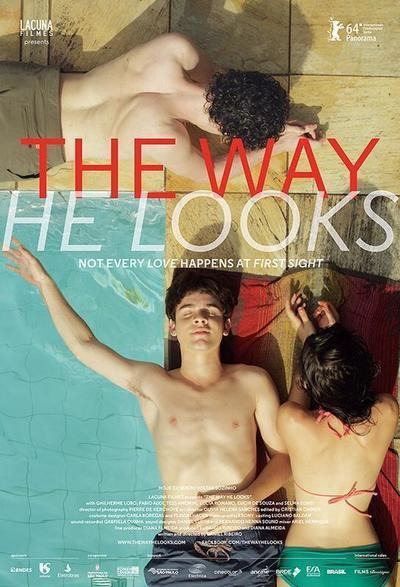
Probably The Way He Looks (2014) because it's an easy layup to introduce folks to the genre. The intersection between Leo's blindness and his queerness gives the newer person multiple things to think about and forces them to consider how queer people are more than just their queerness. I also feel warmly about this film because it was a project we followed all the way from short film to movie, and I love that we were able to get the entire cast back.
Unit 3: Faith and Religion
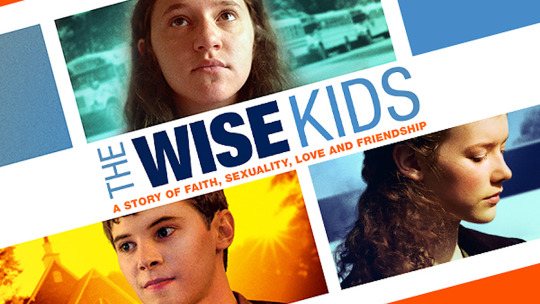
You haven't gotten here, but this is where things start to get especially heavy. I think for this section I'm going with The Wise Kids (2011) because I really like the way Stephen Cone approaches the struggle with faith queer and non-queer people have in evangelical spaces. There's an honesty that I really admire. This is not an easy film, but it's lingered with me for over a decade.
Unit 4: Heartbreak Alley

This is the section of straight losses. I don't know that I ever want to watch it again, but I would probably select Bent (1997) as my favorite because the idea that we could still love even in the greatest of horrors spoke to me. I also think the performances in this adaptation are phenomenal.
Unit 5: Lesbians

I think we just passed Lesbian Visibility Day, so happy birthday, lesbians! This is actually a difficult selection because there are so many great films in this section. I think, today, I'm giving it to The Handmaiden (2016), but I almost chose Bound (1996).
Unit 6: Gems

I don't even need to look to know Big Eden (2000) is in this section. This section whips ass all around, but Big Eden is my favorite because there's just so much love all over this movie, and every new fact I learn about the BTS of it makes me love it more. Arye Gross and Eric Shweig did not have to go as hard as they did in this movie. The director left that choice to them a veteran actors and they did that 23 years ago. Nothing but admiration and respect. This is one of my most beloved films.
Unit 7: Asian Film Warm-up
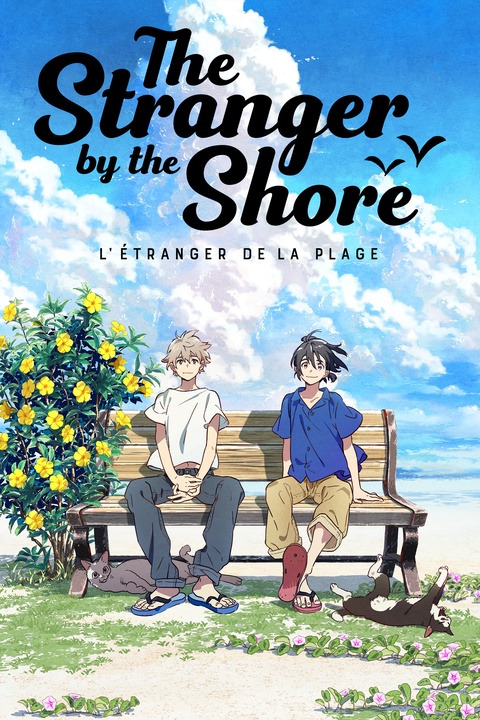
This is a difficult selection because I think it depends on my mood, but for now, I'll go with The Stranger by the Shore (2020). This is a very Japanese take on second-chance romance. I like the way Japan approaches the quiet internalized homophobia that grips us. Some of the same things in Minato's Laundromat can be found here. It's also gorgeous and approaches sex in a frank way that I really loved.
Unit 8: Yaoi

Once again I don't even need to look to know that it's Yuri!!! On Ice (2016). This show is so goddamn gay. I know people feel like it was censored because of the kiss, but these two proposed to each other. It's what sports anime wishes it could be with the open queerness on display from so many characters. It's beautiful and so much fun.
Unit 9: Boys Love

I will not be selecting a favorite BL, but I will say that I really love The Boy Foretold by the Stars (2020) and it's a movie. I loved that we had a femme lead for once and that they explored what faith meant for femmes. It's a film that took the romantic lead's gay awakening very seriously and explored what being together might look like in a sequel called Love Beneath the Stars.
I'm looking forward to you completing the syllabus!
#answered#lgbt film#pariah#the way he looks#the boy foretold by the stars#the wise kids#bent#yuri!!! on ice#the stranger by the shore#big eden#the handmaiden#queer cinema syllabus
80 notes
·
View notes
Text





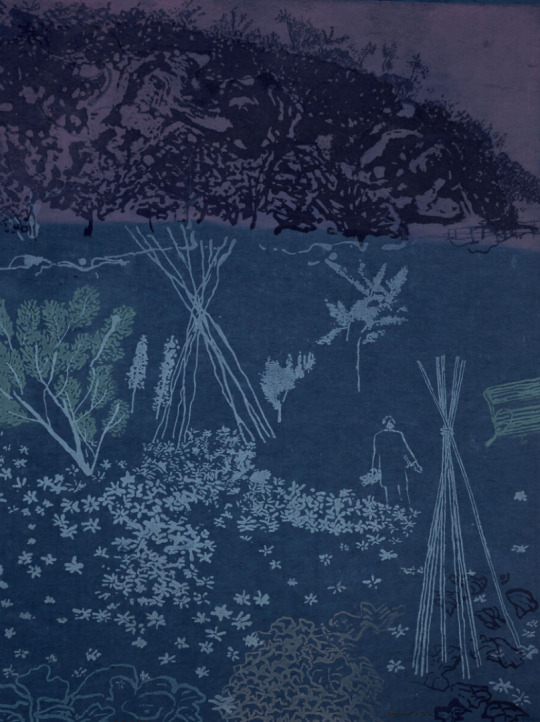


TOM HAMMICK (b 1963, British)
Artist Tom Hammick has described landscape in his work as a metaphor to explore an “imaginary and mythological dreamscape.” Drawing from a wide range of sources, from Japanese woodblock prints to Northern European Romantic painting and contemporary cinema, Hammick’s depictions of isolated human dwellings grounded in uncanny dream-like settings summon the uneasy atmosphere of a psychologically-charged thriller, or a dystopian suburban nightmare.
Hammick was the recipient of the V&A Prize at the International Print Biennale, Newcastle, UK in 2016.. His work is in many major public and corporate collections including the British Museum, the Victoria and Albert Museum, Bibliotheque Nationale de France, Deutsche Bank, the Yale Center for British Art, and The Library of Congress, Washington DC.
hammick.com/
23 notes
·
View notes
Text
Current ask game
Tagged by the dazzling @thewayofsubtext! Thanks so much :D
Current time: 8:30-ish in the morning. A rare morning for this hypersomniac. I see a nap in my future!*
*There was indeed a nap, and now it's 2 pm
Current activity: Catching up on things I've been tagged in, I've gotten very behind with low spoons. But the real question is what am I procrastinating doing, which is cleaning my house so chairs can be delivered.
Currently thinking about: Wondering how long it'll be before I crash and need a nap.* But also planning what I'm going to do with my few days off and how to catch up on all the smaller things on my to do list I've been putting off
*It was 30 minutes give or take
Current favorite song: Gosh favorite songs are hard, ummm let's go with Nauseous by the Rose. I got to see them perform recently so it seems appropriate to pick something by them!
Currently Reading: I was going to say nothing. I don't get much reading done for fun these days (dissertation...sigh). But about an hour ago I ran into a gem which I'm planning to use for my next meta post on Shadow. It's Ghostly Desires: Queer Sexuality & Vernacular Buddhism in Contemporary Thai Cinema by Arnika Fuhrmann
Currently Watching:
Too much and I'm probably going to drop some, so I'll just list what I'm currently enjoying and definitely plan to keep watching
Shadow-It's great! I usually only write meta once in a blue moon but it's got me in a meta frenzy. Plus Singto, Fluke, and Fiat--sign me up! Highly recommend!
One Room Angel-Really enjoying this one so far. It's dealing with heavy emotions and topics in a very Japanese style which I love. We'll see how it sticks the landing this week. I don't mind sad endings if their done well and meaningfully. But I also hope for a happy ending (and that desire is where they really get me as a viewer)
Last Twilight-Like a lot of folks, my disabled ass was wary but held out hope that P'Aof would do this justice a la Moonlight Chicken. The first few episodes showed me that he is at the very least aware of the conversation and ready to handle this with nuanced characters. I can't say I don't have a few quibbles and I'm still waiting for the other shoe to drop, but so far I'm pleased!
My Dear Gangster Oppa-It's really sweet and fun, flaws and all. Hard not to relate to two awkward dudes who never had a lot of friends bonding. Throw in gangsters and gamers and it's a nice watch each week!
Bake Me Please-I really enjoyed the first episode. The characters feel lived in. Plus it's nice to see Guide in a lead role after I Feel You Linger in the Air and alongside Ohm at that. I can't put my finger on it, but something about how they're building out the cast reminds me of Taiwan's style which is interesting to see.
Oh No! Here Comes Trouble-Doing a re-watch with my partner. An absolute favorite! It tackles grief and loss with depth, a strong sense of storytelling, and a quirky sense of humor. Throw in the supernatural and fantastic characters, and I fell in love.
Current Favorite Character: This is too hard! Fine, I'll choose! Pu YiYong from Oh No! Here Comes Trouble
Current wip: Currently working my way to a meta on technology in Shadow
Play away: @thepancakelady @petalsandeverythingnice @ablazenqueen @justanothertraveller42 @thepondstogether @shining-oranges86 @outofthewoods-tv @not-a-real-colour @writerwithoutsound @imminentinertia @kudaai @buffvsummers @chickenstrangers @mirabella96 @superrex319 @broidkwhatibedoinganymore @lady-pascal @synxailla @waitmyturtles @lurkingshan @jemmo
10 notes
·
View notes
Video
youtube
Chinese traditional instruments cover of track “Myriad of Lights” from the 2022 Lantern Rite event by Zi De Guqin Studio/自得琴社. Costumes are Song dynasty style hanfu.
Instruments from left to right in ensemble scene (note: the guy second from right is an actor and did not play an instrument):
Dizi/笛子: transverse bamboo flute; unique characteristic being the dimo/笛膜, or thin bamboo fiber membrane that gives it its unique bright tone.
Erhu/二胡: bowed stringed instrument, has only two strings. Usually serves a primary role similar to a violin.
Guqin/古琴: sometimes translated as “Chinese zither”; seven-stringed plucked instrument that is fairly ancient; in ancient times it was simply referred to as qin/琴, and the gu/古, meaning old or ancient, was added on to the name in modern times.
Dagu/大鼓: traditional large drum; has a variety of uses in ancient times, including raising morale in the military; in modern contemporary Chinese drama/cinema they are commonly used in background music for fight scenes.
Guzheng/古筝: stringed plucked instrument, has movable bridges; in ancient times it was simply referred to as zheng/筝, and the gu/古, meaning old or ancient, was added on to the name in modern times.
Pipa/琵琶: stringed plucked instrument; came from Middle East; originally played horizontally with a plectrum (this can still be seen with Japanese biwa, since pipa was the predecessor of the biwa), and over time it eventually became finger-plucked.
Instrument not included in ensemble scene:
Bo/钹: small cymbal with a greater curvature at the middle (larger cymbals with less curvature are usually referred to as Cha/镲); here played using small mallets.
#genshin impact#genshin music#music#chinese instruments#zi de guqin studio#hanfu#chinese hanfu#song dynasty#lantern rite#lantern rite 2022
114 notes
·
View notes
Note
What kind of research did you do when writing Ronin to adapt elements of traditional, feudal Japan into Star Wars? I’ve always been fascinated by that era but have been unsure how to appropriately incorporate aspects of that culture and history into my work.
So I had the fortune of exposure to the study of Japanese history and culture not only through my family history but through high school in Hawaii. Also, I got to do some deep dives through classes in undergrad! Specifically into the history of Japanese religion and folklore, which necessarily entailed a study of the times in which any specific belief or practice was developing, etc., as well as post-war culture and literature. And about half a class's worth of the study of Japanese maps before I had to tap out for thesis reasons. (IT WAS INCREDIBLY INTERESTING; THE WAY PEOPLE REIFY SPACE THROUGH MAP DRAWING? THE IMPLICIT POWER AND CONSTRUCTION OF THE WORLD?? INCREDIBLE.) Which is to say I had a pretty solid primer going into Ronin :P
Thus when I started figuring out what Ronin was going to be, my immediate thought was to approach it from the angle of post-war cinema, because "The Duel" is v clearly a Kurosawa pastiche. So I'd say it's less a depiction of feudal Japan than it is a story using the lens and aesthetic of feudal Japan to speak to a contemporary problem. Kurosawa and auteurs like him were drawn to samurai and ronin as metaphor, and for a variety of reasons, but one of the most frequent problems you see them using those sad swordsmen to confront is: "hey, soooooo, my lord (read: gov't) told me to go be very violent at some guy, and i did go do that, but my feelings about it are.........complicated maybe. uh oh. is this what an existential crisis feels like? UH OH."
Which is all to say, for this book I was drawing both from scholarship on the history of Japan as well as from Japanese cinema, literature, and storytelling that has used that history to tell stories implicitly about other histories. And I would really recommend digging through those stories and analyses of them!!
9 notes
·
View notes
Photo



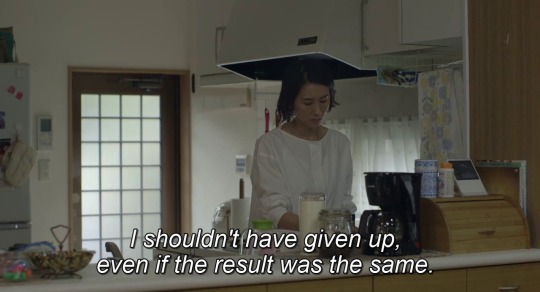
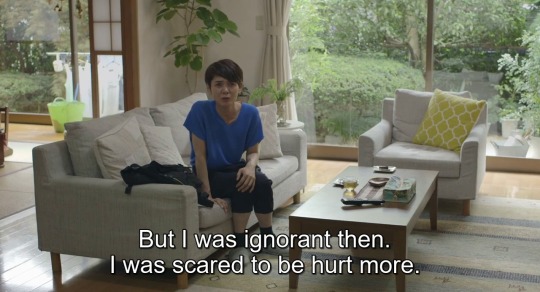
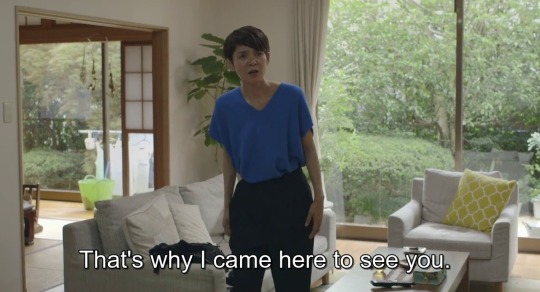
偶然と想像 [Wheel of Fortune and Fantasy] (Ryusuke Hamaguchi - 2021)
#偶然と想像#Wheel of Fortune and Fantasy#Gūzen to Sōzō#Ryusuke Hamaguchi#love triangle#self-esteem#feelings#anthology romantic drama film#Kotone Furukawa#women#Contemporary Japanese Cinema#Kiyohiko Shibukawa#life#Far east cinema#Katsuki Mori#Fusako Urabe#Aoba Kawai#Ayumu Nakajima#Hyunri#Shouma Kai#society#wisdom#books#writers#literature#Il gioco del destino e della fantasia#偶然与想象#La ruleta de la fortuna y la fantasía#psychology#happiness
18 notes
·
View notes
Text
One of you guys said u were interested in reading my PDF for class and i finished earlier than i thought so here u go!!!
16 notes
·
View notes
Text
Movie Review: Godzilla Minus One reflects the greatness and spectacularity of quality cinema

1954 marked a before and after in science fiction and fantasy cinema, this genre so popular today has seen endless stories parade on the big and small screens, ranging from the most original to the adaptations of novels by great contemporary writers.
Toho Co., Ltd. is a Japanese high entertainment company that stands out mainly for the production and distribution of films and the production and exhibition of plays. This studio was responsible for bringing one of the most iconic monsters in film history.
Godzilla is a gigantic fictional kaiju monster. Its creation and conception in the mid-1950s ended in a film directed and co-written by Ishirō Honda and since then this colossal creature has become a representative icon of Japan and pop culture. appearing in 32 Japanese films produced by Toho Co., Ltd., five American films, and numerous video games, novels, comics, and television shows.
2023 marked the return to the big screen of this kaiju in Japan, Godzilla Minus One is his thirty-third film, directed by Takashi Yamazaki, this film is probably a reboot of the entire franchise as we know it today or, it is opening the door to a multiverse of probabilities in which we can see new things with older overtones.
What is the film about?
After the war, a desolate and devastated Japan witnessed the emergence of a monster called Godzilla, leading the country to even greater destruction. In the moment of greatest desperation, the inhabitants will join forces to try to combat this threat before it ends. with everything and everyone.
That Japan returns to this character on the big screen is one of the best things that could happen to this franchise, although on the one hand, we have the Western monsterverse that is becoming more and more popular, it is the original that causes the most expectation among its own and strangers, in 2024 Godzilla will turn 70 years old and to celebrate, its parent company Toho Co., Ltd. is bringing forward its celebration in style.
To talk about Godzilla is to refer to a franchise that has been very successful over the years. We can say that Godzilla Minus One is the most conventional film of recent times or the most sobering and least extravagantly pretentious work produced in Japan since the original from 1954, this is not intended to be a reboot or a continuation of what we already know, it is a midpoint between a promising future that opens and transforms its original franchise and a past that still has a lot to tell.
Set in 1946 where a group of ex-military members exhausted after the passage of a war come together to try to defeat a creature unknown to all, a being about which they know absolutely nothing and that threatens to end the devastation, among the survivors is the Kamikaze pilot Koichi Shikishima (Ryunosuke Kamiki) who after a stop on an island witnesses that they cannot stop Godzilla, he will destroy Ginza and then all of Tokyo.
Koichi suffers from survivor's guilt, for not having done what was necessary to defend his people and his comrades who had fallen in battle. This is how the film opens, placing us on Odo Island, where this giant makes his appearance, destroying the surviving military camp. Koichi from his plane aims at Godzilla and in a panic he does not dare to shoot him, as a result, several of his companions die, one of the fundamental axes in the story is the fact that its main character has to relive the patriotic feeling and the consequences that this brings to his life after the war.

This type of nationalistic passion is essential to fighting Godzilla and at the same time having to take care of other survivors most of whom have also lost their loved ones, their homes, and their will to fight, we can see this in a very superficial way the havoc caused by war, hunger, lack of resources, people's fear of the unknown, facing a harsh and cruel reality in which no one has more than their own life, the latter is crucial and is not intended to give us a moral discourse simply poses what survivors would do in the face of an even greater threat.
The human factor in the Godzilla films is fundamental and serves as the guiding thread of a story seen through the eyes of someone ordinary, a rule established by Ishirō Honda from the beginning, whether they are men or women or children or an entire population. which witnesses the devastation that this giant causes when facing a vulnerable humanity or an enemy at its height, in this case, there is an intense need to demonstrate the worth that people have when facing an unknown enemy and an even more future uncertain.
Koichi teams up with Kenji Noda (Hidetaka Yoshioka), a former weapons engineer, and Sosaku Tachibana (Munetaka Aoki), a former Navy mechanic. Each one has a development parallel to that of the protagonist. The film establishes that their fears are based on their traumas. of the post-war period, the female co-stars, the affectionate and selfless Noriko Oishi (Minami Hamabe) and her recently orphaned adopted daughter Akiko (Sae Nagatani), are the motivation to fight in another war where no one knows what it will end in.
Although we see very little of Godzilla within the film, it is due to another of the rules established by Honda, unlike his appearances here we can see and appreciate that his appearances are very well calibrated and it is simple, he appears when he should appear, not before. nor after, this is what greatly enriches this project, as connoisseurs and fans of this genre we are more than pleased with the result, and those who are not, will be pleasantly surprised.
Writer and director Takashi Yamazaki focuses on representing more of a question of national honor than a giant monster that destroys everything, a plot that complements very well with the subplots that directly involve part of what Japanese military culture is, and immediately jumps out. on display when the locals curse Koichi for failing to do his duty and allowing the devastation to continue even two years later. The traumas lead him to wonder if this is real life or if he is just trapped in a post-war hell as punishment for his cowardice.
Themes that are deep and serious enough to be dealt with in the middle of the attack of something giant and unknown, possibly it is in this very specific point where the success of Godzilla Minus One lies, the story in general does not take so many restrictions nor does it worry about falling into excess of explanations, an idea that is taken and paid homage to that of 1954 where at every moment we can make a comparison between the two without detracting from the merit and importance of each one.
No matter how convincing the human part is within this same work, Yamazaki does not allow this to be a distraction from the main event, Godzilla himself, another thing that is surprising in the middle of 2023 is that this film is a cleaner and more honest cinema, while other productions make an impressive waste of visual effects that serve to complement a plot, here things change, as visual effects director alongside Kiyoko Shibuya, Yamazaki presents a Godzilla very different from his current American counterpart without losing that wonderful feeling of having a person wearing a bag made of cloth and rubber.
The quality of the effects is at the level of what is required for a film of this type, what should impress us is not only the creature but how it interacts with its environment, it is not about destroying for the sake of destroying, although one would think that Making a model and putting someone to wreak havoc on it is simple, the reality is that it is more complicated than it seems, a filming process like this not only takes hours of planning but days and even weeks in its execution for it to be completed. See as realistic as possible within how unbelievable it can be.
Its ending is something completely new and worth seeing, something that tells us that there will be more of this Godzilla in the future and that he is not as indestructible as in previous films, this contribution greatly enriches this new franchise and takes it to another level within itself, reinvention is not something that can be handled so easily and here it is so simple to propose that it not only convinces a demanding audience it also flaunts everything we can expect, a monster that dies but can regenerate? The idea sounds crazy but here it is perfectly well executed and justified.
Perhaps, and I say perhaps, the biggest flaw that this film has is in the proportions from small to large and vice versa, as well as its perspective when changing from one scene to another, for example, in the almost climactic part we see a very good Godzilla. planted and balanced on a seabed, moments later we see that the depth of the ocean in which they are exceeds it by 100 to 1, this seems to be something already established and not a sequential error, we have seen it in other productions of the genre, series animated, and even in comics.
Another detail to consider if we are talking about a colossal creature, something very similar happens with movements on land that are more clumsy or with the displacement of the water when it is swimming, these details can go unnoticed and can be justified because we are dealing with a job. merely fantastic that aims to be as realistic as possible.

Unlike Toho Co., Ltd's latest production, the equally excellent Shin Godzilla (2016), the monster's design continues to have fundamental bases of something similar to a dinosaur, we can see a partial evolution, a young Godzilla that appears at the beginning and that reminds us of a T-Rex attack sequence in the first Jurassic Park film (1993) and it is until the middle and towards the end where we can see it in all its splendor, another contribution that Yamazaki makes to this franchise is to reinvent its atomic breath, here seen as a buildup of atomic energy that activates along with the scales on its back when they turn blue, followed by a mushroom cloud at the point of impact that destroys the surrounding area that first radiates. and then it implodes, when we see this on screen there is a total absence of sound which gives more drama to the sequence.
It cannot be overlooked that the central message in the 1954 film was the use of atomic weapons, Minus One's Godzilla once again represents the uncontrollable destruction that these cause and the consequences that exist in its environment and its fauna, It is very well stated that Godzilla here is the result of this, a being that is not a dinosaur but is a mutant humanoid creature that perhaps is only looking for a place in a world that it does not know and that equally terrifies it as it terrifies us as humans. presence, here there is already a link between the monster and wars in general, a synonym for destruction and seemingly unstoppable death without a motivation that is understandable to us.
This sudden and surprising change in the character's line not only reveals the commercial ambition of the studio but also competes with its American namesake, which completely distances itself from any nationalism and patriotic message, despite all the violence on screen Godzilla Minus One It is an infinitely hopeful film that reaffirms the survival of humans as a dominant species that sees in Godzilla a representation of the warrior nature we have to face adversity and the determining will to live.
The cast is made up of Ryunosuke Kamiki, Minami Hamabe, Yuki Yamada, Munetaka Aoki, Hidetaka Yoshioka, Sakura Ando, and Kuranosuke Sasaki who understand their characters perfectly well and what they must face, their construction is still based on the first film that here it is recreated in a more current, modern, convincing and terrifying way.
The music composed by Naoki Satō has precise samples of what was composed by Akira Ifukube for the 1954 Gojira without losing its personality, each piece is perfectly well cared for and synchronized so that as spectators we can become audiovisually involved in a great show.
In conclusion, Godzilla Minus One is a clear example and shows us that with a very modest budget of less than 15 million dollars, you can make a great film, that it is not necessary to make a commercial waste to present a mediocre product, that when projects like this, they are in the right hands with a concrete and precise approach to where they want to go. These are the results.
A worthy, honest, and awe-inspiring work, it takes all the classic elements such as Godzilla's scream and transforms them not in a modern way but with a vision of the past that marks the beginning of a new future, something very worthy of presenting to the new generations and that is up to the task of competing with any monster verse, what took the West 5 films, a comic book prequel, and a television series, it was enough for the East just to do this to capture the world's attention.
A film that has already been positioned as one of the best of the year is already a classic and that plans to have a re-release in Japan in a more classic format in black and white, without a doubt the projects of this studio will give a lot of something talk in the future and we look forward to more work like this at a very high level.
Godzilla Minus One is now out in theaters in your country.
https://www.youtube.com/watch?v=PShgB-ielBI
Read the full article
4 notes
·
View notes
Text
slowly watching more 2023 films. maybe I'll actually keep up with contemporary cinema this year (that's a lie it's just going to be 20 or 50 year old Japanese films again)
4 notes
·
View notes
Note
hey M, before you left your blog I wanted so much to ask you about cinema and I didn't get a chance back then but since you are back I'm glad I have an opportunity to do so and here I go.
Who and what do think played a huge role in the rise of independent filmmaking in the 70's that helped breaking boundaries within GP and against major studios whether in concept, scenario/story cinematography..etc. and do you think such movement might be accomplished in our era knowing how technology is so advanced - AI in particular- to the point it removed many aspects that define the art of cinema?
I know Tech is a double edged sword but these days I feel its negative impact more than ever and imo, the amount of remakes is a huge sign that we have reached the ending line, and I hope that going back to the roots is a possible feature that is yet to be invested in.
I feel my questions are little bit thick lol, so sorry in advance.
Hi @astutejiminie! Thanks for the question, this is something that I'd love to talk about.
In short and in hindsight as well, it's almost like it was inevitable if we look at the situation the studios were in the 1960s, but also at the socio-economic and political factors. It's all tied together.
By the mid to late 60s, it became obvious the big Hollywood studios weren't making money anymore. Television came and that affected the way the usual movie goer behaved. Since it was new, it had a success quite from the beginning. The studios were also investing a ton of money in a few select genres thinking it's the magic formula that can bring audiences back. Musicals and epics in technicolor. Most of them failed critically and also didn't make any profit. Only a few did, like The Sound of Music for example. Another aspect was that Hollywood played it safe in the 50s-60s, the Hays code was still on until 1968 which was restrictive and puritanical. And now we're getting to the bigger picture. How would a young audience in the late 60s could possibly be interested in that anymore? When they could easily buy a ticket to some European film that showed them morally ambiguous characters, sex and less conformism? There was no way Hollywood could survive if they didn't adapt. And they saw early on that some of the films obviously inspired by world cinema (especially Europe) were actually worthwile (see Bonnie and Clyde). And from that point on, filmmakers, writers, were given freedom and means of production, without the studios being completely in control of a film. The director was. And a lot of them were young people high on European and Japanese cinema and they helped bring in a new era. One that had a huge effect and still has on the way contemporary American film looks like. They owned the 70s.
And then the era of blockbuster came in and that has had a major effect as well, until today. Jaws made a lot of money. Star Wars too. The box office success was huge. The 1980s focused again on investing money, an easy plot to follow, a story that looked spectacular and so on. And still, those filmed looked better made than some current Hollywood super hero movie that is not bringing a wide variety of audiences back to the cinema.
We've been stuck with remakes, sequels and prequels and cinematic universes and countless shows on streaming platforms. A saturated market that offers nothing. We need good Hollywood movies. A diversity in genre films. What Barbie and Oppenheimer are doing this summer is great. Both are films that don't insult their audience, are mainstream but also cater to audiences coming from different backgrounds and people are excited. The tickets are sold out. But I do fear it's but one singular example and it will take another 10-15 years until something similar happens again.
For now, the situation looks bleak and the rise of AI used in the industry only makes it worse. Which is why the actors and the writers strikes are so important. They need to fight against it and gain some control. The big studios and streaming platform CEOs don't care about cinema and television. About the craft. They want to get rid of extras and replace them with a digital version. They will make more and more use of technology to write the scripts. As long as they spend less money on actual people, then that's great for them. Which is why the negotiations are so difficult. It's scary and I find it daunting that this dystopic scenario might happen in my life time.
As much as the movie and tv business is entertainment, it is also art. Simply because it involves people creating something. No AI can replicate what a person can do. Their emotions and intellect that is reflected in what they make.
Yes, going back to some formula of the 1970s sounds good but on a big scale, that's not possible because we live in such a different world. Some smaller studios are still releasing more quality works, like A24. But an entire industry is a lot more. Hollywood is the studios that make it. What's important is how those studios adapt and negotiate with the people that also keep Hollywood running and not lose its meaning. It won't disappear. But over time, people get replaced, new business ideas come in and the dream lives on. Hopefully on better terms than presently.
9 notes
·
View notes
Text

Nightmare Japan: Contemporary Japanese Horror Cinema : Jay McRoy : Free Download, Borrow, and Streaming : Internet Archive
2 notes
·
View notes